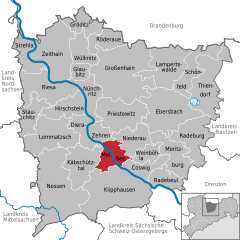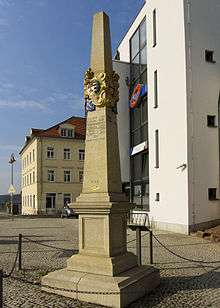Meissen
| Meissen | ||
|---|---|---|
|
Albrechtsburg and Cathedral | ||
| ||
 Meissen | ||
Location of Meissen within Meißen district 
 | ||
| Coordinates: 51°10′N 13°29′E / 51.167°N 13.483°ECoordinates: 51°10′N 13°29′E / 51.167°N 13.483°E | ||
| Country | Germany | |
| State | Saxony | |
| District | Meißen | |
| Government | ||
| • Mayor | Olaf Raschke | |
| Area | ||
| • Total | 30.90 km2 (11.93 sq mi) | |
| Population (2015-12-31)[1] | ||
| • Total | 27,936 | |
| • Density | 900/km2 (2,300/sq mi) | |
| Time zone | CET/CEST (UTC+1/+2) | |
| Postal codes | 01654–01662 | |
| Dialling codes | 03521 | |
| Vehicle registration | MEI | |
| Website | www.stadt-meissen.de | |
Meissen (in German orthography: Meißen, IPA: [ˈmaɪsn̩]) is a town of approximately 30,000 about 25 km (16 mi) northwest of Dresden on both banks of the Elbe river in the Free State of Saxony, in eastern Germany. Meissen is the home of Meissen porcelain, the Albrechtsburg castle, the Gothic Meissen Cathedral and the Meissen Frauenkirche. The Große Kreisstadt is the capital of the Meissen district.
Names
- German: Meißen, Meissen
- French: Misnie
- Latin: Misnia, Misena, Misnensium
- Polish: Miśnia
- Czech: Míšeň
- Upper Sorbian: Mišno
- Lower Sorbian: Mišnjo
- Russian: Майсен, Мейсен
History
Samo's Empire 631-658
![]() Margraviate of Meissen 968–1002
Margraviate of Meissen 968–1002
Poland 1002
![]() Margraviate of Meissen 1002–1423
Margraviate of Meissen 1002–1423
![]() Electorate of Saxony 1423–1697
Electorate of Saxony 1423–1697
![]() Poland-Saxony 1697–1706
Poland-Saxony 1697–1706
![]() Electorate of Saxony 1706–1709
Electorate of Saxony 1706–1709
![]() Poland-Saxony 1709–1763
Poland-Saxony 1709–1763
![]() Electorate of Saxony 1763–1806
Electorate of Saxony 1763–1806
![]() Kingdom of Saxony 1806–1871
Kingdom of Saxony 1806–1871
![]() German Empire 1871–1918
German Empire 1871–1918
![]() Weimar Republic 1918–1933
Weimar Republic 1918–1933
![]() Nazi Germany 1933–1945
Nazi Germany 1933–1945
![]() Allied-occupied Germany 1945–1949
Allied-occupied Germany 1945–1949
![]() East Germany 1949–1990
East Germany 1949–1990
![]() Germany 1990–present
Germany 1990–present
Meissen is sometimes known as the "cradle of Saxony". The city grew out of the early Slavic settlement of Mis(s)ni, named for the small river Mis(s)na today Meis(s)abach (see Miesbach/Musbach/Mosbach), inhabited by the Slavic Glomacze tribe and was founded as a German town by King Henry the Fowler of Germany in 929. In 968, the Diocese of Meissen was founded, and Meissen became the episcopal see of a bishop. The Catholic bishopric was suppressed in 1581 after the diocese accepted the Protestant Reformation (1559), but re-created in 1921 with its seat first at Bautzen and now at the Katholische Hofkirche in Dresden.
The Margraviate of Meissen was founded in 968 as well, with the city as the capital of the Margraves of Meissen. A market town by 1000, Meissen passed to the Duchy of Poland in 1002 under Boleslaw I the Brave, afterwards into hands of Henry II a few months later and the House of Wettin in 1089. In 1015 Meissen was besieged by the Poles led by future King Mieszko II. The city was at the forefront of the Ostsiedlung, or intensive German settlement of the rural Slavic lands east of the Elbe, and its reception of city rights dates to 1332.
The construction of Meissen Cathedral was begun in 1260 on the same hill as the Albrechtsburg castle. The resulting lack of space led to the cathedral being one of the smallest cathedrals in Europe. The church is also known as being one of the purest examples of Gothic architecture.
In 1423 Meissen became capital of the Electorate of Saxony. In 1464 the capital was moved to Dresden.
In 1759 the Austrians defeated the Prussians at the Battle of Meissen.
During World War II, a subcamp of Flossenbürg concentration camp was located in Meissen.[2]
Porcelain

Meissen is famous for the manufacture of porcelain, based on extensive local deposits of china clay (kaolin) and potter's clay (potter's earth). Meissen porcelain was the first high-quality porcelain to be produced outside of the Orient.
The first European porcelain was manufactured in Meissen in 1710, when by decree of King Augustus II the Strong the Royal-Polish and Electoral-Saxon Porcelain Factory (Königlich-Polnische und Kurfürstlich-Sächsische Porzellan-Manufaktur)[3] was opened in the Albrechtsburg. In 1861, it was moved to the Triebisch river valley of Meissen, where the porcelain factory can still be found today. Along with porcelain, other ceramics are also manufactured.
Main sights

The Albrechtsburg, the former residence of the House of Wettin, is regarded as being the first castle to be used as a royal residence in the German-speaking world. Built between 1472 and 1525, it is a fine example of late Gothic style. It was redecorated in the 19th century with a range of murals depicting Saxon history. Today the castle is a museum. Nearby is the 13th-century Gothic Meissen Cathedral (Meißner Dom), whose chapel is one of the most famous burial places of the Wettin family. The hill on which the castle and the cathedral are built offers a view over the roofs of the old town.
Meissen's historical district is located mostly around the market at the foot of the castle hill. It contains many buildings of Renaissance architecture. Also imposing is the view from the 57 metre high tower of the Frauenkirche (Church of Our Lady), situated in the old market-place. This church, not to be confused with the Dresden Frauenkirche, was first mentioned in a 1205 deed issued by Bishop Dietrich II and after a blaze about 1450 rebuilt in the Late Gothic style of a hall church. Its tower hosts the world's first porcelain carillon, manufactured in 1929 on the occasion of the town's 1000-years-jubilee. Another popular tourist sight is the world-famous Meissen porcelain factory.
From spring to autumn, several festivals take place in Meissen, such as the pottery market or the Weinfest, which celebrates the wine harvest. Meissen wine is produced at the vineyards in the river valley (Elbtal) around the town, part of the Saxonian wine region, one of the northernmost in Europe.
Notable residents

- Saint Benno, Bishop of Meissen, born about 1010 in Hildesheim, died June 16, 1106
- Heinrich Frauenlob, poet, born 1250/60, died November 29, 1318 in Mainz
- Johann Klaj, poet, born 1616, died February 16, 1656 in Kitzingen
- Johann Elias Schlegel (1719–1749), critic and poet
- Johann Adolf Schlegel (1721–1793), poet and clergyman
- Samuel Hahnemann (1755–1843), physician and founder of Homoeopathy
- Karl G. Maeser (1828–1901), Mormon academic
- Hans Philipp (1917–1943), combat pilot
- Ralf Schumann (born 1962), Olympic shooter
- Peter Schreier (born 1935), opera singer and conductor
Twin towns – sister cities
Meissen is twinned with:
 Vitry Sur Seine, France, since 1973
Vitry Sur Seine, France, since 1973 Arita, Japan, since 1979
Arita, Japan, since 1979 Corfu, Greece, since 1996
Corfu, Greece, since 1996 Provo, Utah, US, since 2001
Provo, Utah, US, since 2001
See also
References
- ↑ "Aktuelle Einwohnerzahlen nach Gemeinden 2015] (Einwohnerzahlen auf Grundlage des Zensus 2011)" (PDF). Statistisches Landesamt des Freistaates Sachsen (in German). July 2016.
- ↑ Christine O'Keefe. Concentration Camps. tartanplace.com
- ↑ http://www.starcookers.com/magazin/orte-zum-geniessen/meissner-porzellan/
External links
| Wikimedia Commons has media related to Meißen. |
| Wikisource has the text of the 1920 Encyclopedia Americana article Meissen. |
| Wikivoyage has a travel guide for Meißen. |
- Municipal website (German)
- GCatholic.org
- Meissen Porcelain Dealer in NY
- Further information on Tourism
- Webcam Meissen (German)

